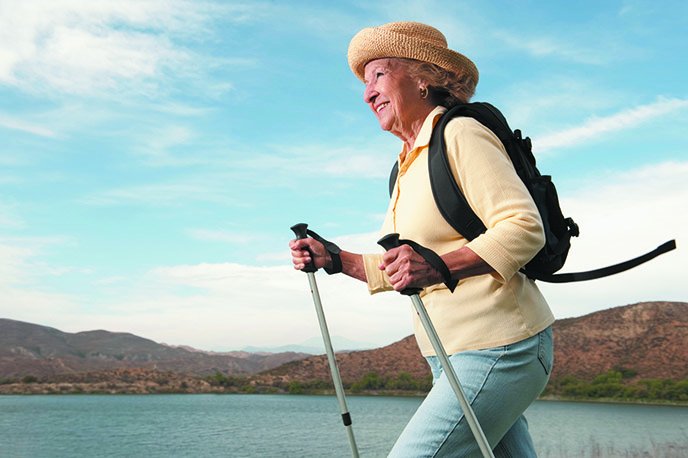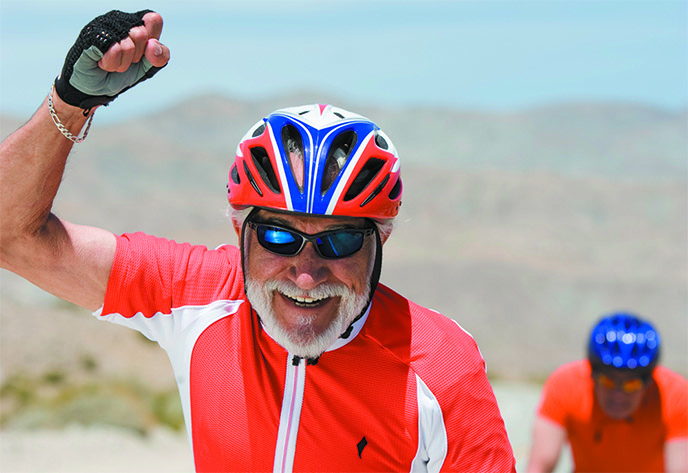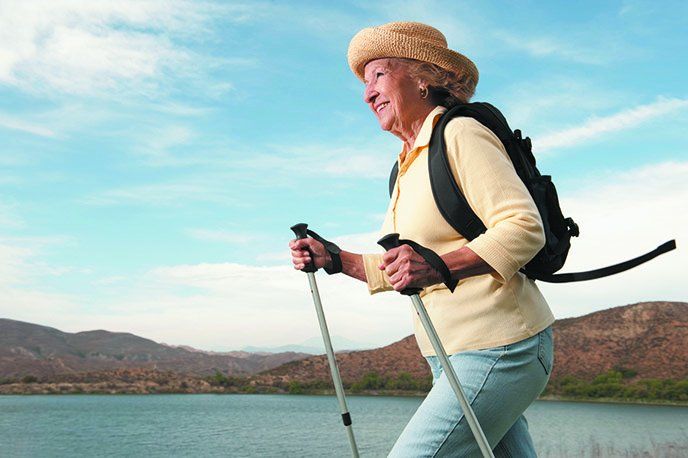Image: Thinkstock

If you’re looking for motivation to get up off the couch, the results of a large new European study may be just what you need to lace up those walking shoes. Even a moderate amount of exercise—the equivalent of a daily brisk 20-minute walk—was associated with significant reductions in mortality risk. Physical activity contributed to longevity independently of weight loss, and the biggest potential benefits were seen simply by going from completely sedentary to “moderately inactive.”
“Along with good, wholesome nutrition, there is no more important thing you can do for your health than move your body,” says Tufts professor Miriam E. Nelson, PhD, author of the “Strong Women” book series. She advises: “Get your heart rate up, use your muscles and expend more energy. A regular exercise routine protects your heart, increases bone density, ups your energy level, retards the muscle atrophy and creeping frailty that occur as we age, and is crucial for weight control.”
SEDENTARY VS. MODERATELY INACTIVE: Physical activity has consistently been associated with protection from chronic disease and reduced mortality risk. But it hasn’t been clear whether these benefits are entirely because exercise contributes to weight loss, or whether physical activity exerts effects independent of weight and waistline.
To help answer this question, researchers led by Ulf Ekelund, PhD, of the University of Cambridge, looked at data from the European Prospective Investigation into Cancer and Nutrition (EPIC) study. This study measured body mass index (BMI) and waist circumference among 334,161 men and women, who were then followed for an average of 12.4 years. Participants also reported their occupational and recreational levels of physical activity; 22.7% were classified as “inactive,” combining a sedentary job with no leisure-time activity.
Over the follow-up period, 21,438 participants died. According to findings published in the American Journal of Clinical Nutrition, those in the “moderately inactive” group were at up to 30% lower mortality risk than those who were completely inactive. Adding enough daily activity to burn 90-110 calories—such as a brisk 20-minute walk—would move an individual from the high-risk inactive category to the “moderately inactive” group, researchers noted.
“This is a simple message,” Ekelund said. “Just a small amount of physical activity each day could have substantial health benefits for people who are physically inactive.”
WEIGHT AND WAIST SIZE: Across all BMI levels, moderately inactive participants saw a 20-30% lower mortality risk compared to their inactive peers. Greater activity further boosted this difference in normal-weight and overweight participants; active normal-weight people, for example, saw a 41% lower mortality risk compared to inactive normal-weight individuals. Among obese participants (BMI greater than 30), no additional risk reduction was seen beyond that for the moderately inactive group. Similar results were observed when participants were grouped by waist circumference.
Overall, researchers estimated that the mortality effects of physical inactivity were more than twice those of obesity and similar to that of large waist circumference.
“Helping people to lose weight can be a real challenge,” noted researcher Nick Wareham, PhD, of the University of Cambridge, “and while we should continue to aim at reducing population levels of obesity, public-health interventions that encourage people to make small but achievable changes in physical activity can have significant health benefits and may be easier to achieve and maintain.”
“Although we found that just 20 minutes would make a difference,” Ekelund added, “we should really be looking to do more than this. Physical activity has many proven health benefits and should be an important part of our daily life.”
HOW MUCH?: The Physical Activity Guidelines for Americans <www.health.gov/PAGuidelines> recommend that adults should do at least 150 minutes (2 hours and 30 minutes) a week of moderate-intensity, or 75 minutes (1 hour and 15 minutes) a week of vigorous-intensity aerobic physical activity, or an equivalent combination. Aerobic activity should be performed in episodes of at least 10 minutes, and preferably, it should be spread throughout the week. In addition, it is recommended that adults also strength train twice per week.
The guidelines emphasize that everyone should avoid inactivity. Some physical activity is better than none, and adults who participate in any amount of physical activity gain some health benefits.
Engaging in enough daily physical activity to burn about 100 calories can be the difference between a high-risk sedentary lifestyle and being moderately inactive. Of course, youll want to aim for a greater level of activity over time, but just getting going can pay big dividends. Here are examples of activities that burn about 100 calories, depending on your weight, in about 20 minutes:

Older people who are highly fit, such as recreational cyclists, are physiologically more similar to young people than to more sedentary seniors. Thats the conclusion of a new British study that sought to explore the effect of physical activity on key indicators of aging. As one scientist put it, Being physically active makes your body function on the inside more like a young persons.
Before beginning a formal exercise program, advises Tufts Miriam E. Nelson, spend two weeks finding ways in your routine to decrease a sedentary lifestyle. For example, I walk to work, and I dont waste time driving around the mall looking for a spot close to the entrance. I also walk or ride my bicycle when I can, and do not shy away from some of the heavier outdoor work around the house, including raking leaves, shoveling snow and stacking wood.
Obviously, she cautions, if youve been sedentary for most of your adult life, you should start small and safe. But just about everyone can think of ways to incorporate a little more physical activity into their lives here and there, even if its as simple as taking something upstairs every time you think of it rather than building a pile at the bottom of the stairs to take up in one trip at the end of the day.
























